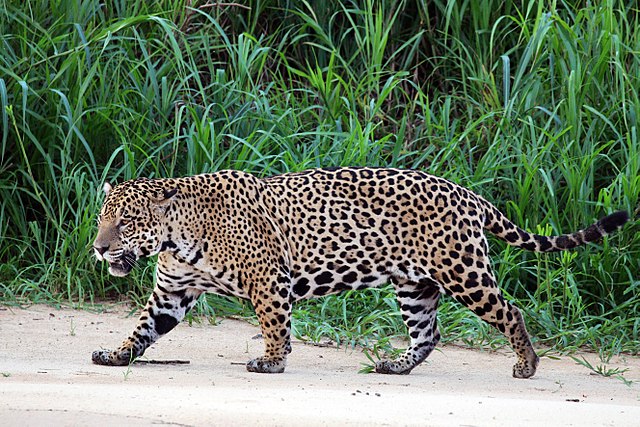
The predawn silence was broken by the subtle rustle of foliage as a muscular, young jaguar, emerged stealthily from the eastern shadows. It was 4 am, and the creature paused momentarily before the motion-sensing camera, almost as if acknowledging its presence before the lens.
“It was overall a moment of euphoria,” says Emily Burns, programme director at the Sky Island Alliance conservation group in Arizona.
“I was equal parts thrilled and shocked that there was a jaguar here.”
Once a majestic inhabitant of the American southwest, the jaguar had faced a grim fate, hunted to local extinction by the 1960s. However, whispers of its return began to stir in the 1990s amidst the rugged peaks of the Sky Islands straddling New Mexico and Arizona. Now, a string of sightings in the region over the past year hinted at the endangered predator’s resurgence.
Yet, the path to reestablishing a jaguar population in the US was strewn with obstacles. Climate extremes loomed large, alongside rampant habitat loss and the lingering scars of the Trump administration’s divisive border policies. The construction of the border wall, slicing through wildlife corridors and fracturing ecosystems, stood as a stark reminder of the challenges ahead.
In November 2023, a remarkable image captured by the Sky Island Alliance unveiled a large jaguar traversing the wooded slopes of the remote Whetstone Mountains in southern Arizona. This snapshot, unveiled exclusively to the Guardian, marked the fifth documented sighting of a jaguar in the US that year. By December, a wildlife camera further chronicled the feline’s journey as it ventured southward, likely towards the Mexican border, passing through the Huachuca mountains.
The Whetstone and Huachuca mountains, integral parts of the Sky Islands, epitomised the stark contrast between the lush biodiversity of their peaks and the arid expanses below.
“You can just imagine a jaguar stopping somewhere like this for a drink,” says Burns. Jaguars’ primary prey, the pig-like javelina, lives here, and springs provide year-round water.
“I often think of these mountain ranges as stepping stones, providing different habitats, different food sources, often more abundant water,” says Burns.
Another jaguar was detected here by Sky Island Alliance in May 2023, but it is not known if it is the same cat as photographed in December.
“If these mountains can support jaguar, it means it is a great habitat for so many other species as well.”
Within their folds lay crucial habitats for jaguars, with nearly half of the US sightings occurring along this vital corridor, as noted by Myles Traphagen, the Wildlands Network’s borderlands program coordinator.
Louise Misztal, executive director at Sky Island Alliance, says: “We know the western flank of the Huachuca mountains and the San Rafael valley provide one of the last open corridors for the northernmost population of jaguars to move between habitat in the US and Mexico. To recover these cats in the US, it’s vital that we protect this pathway.”
However, the jaguar’s newfound freedom and the fragile promise of its return were imperilled by the looming presence of the border wall. Initiated during the Trump era and persisting despite Biden’s opposition, this barrier not only severed vital wildlife routes but also jeopardised the survival of numerous endangered species, including ocelots, Mexican grey wolves, and Sonoran pronghorns.
“The border wall is nearly insurmountable to anything much larger than a badger,” says Russ McSpadden, south-west conservation advocate for the Center for Biological Diversity in Arizona.
Forced to navigate around the imposing structure, jaguars expended precious energy in their quest for sustenance, exacerbating the strain on already diminishing resources in the warming southwest.
“A jaguar is accustomed to going to certain water sources known throughout its life,” says Traphagen, who has co-authored a study on the border wall’s impact on jaguar energy expenditures. “With the border wall, they must travel much greater distances to find that water.”
Krista Schlyer, a seasoned photographer and environmental advocate, recounted poignant encounters with stranded animals along the border wall. From anxious javelinas pacing fruitlessly to jaguars thwarted in their search for refuge, the toll of this divisive barrier was starkly evident.
“They were smelling for their family on the other side,” Schlyer says. The javelinas finally gave up, returning in the direction they had come.
McSpadden says: “It is critical that we actively protect [jaguars’] habitat and habitat connectivity in the south-west. Freedom to roam across vast territories is written into the DNA of jaguars.”
Traphagen somberly warned that the resumption of border wall construction could spell the jaguar’s demise in the US—a poignant reminder of the delicate balance between human policy and the preservation of endangered species in the fragile tapestry of the American southwest.
“The drum beat to finish the wall is here,” he says of the growing support for the border wall. “If they walled off the San Rafael valley, jaguar recovery would come to a standstill.”
——————————————————————————
At Natural World Fund, we are passionate about stopping the decline in our wildlife.
The decline in our wildlife is shocking and frightening. Without much more support, many of the animals we know and love will continue in their decline towards extinction.
When you help to restore a patch of degraded land through rewilding to forests, meadows, or wetlands, you have a massive impact on the biodiversity at a local level. You give animals a home and food that they otherwise would not have had, and it has a positive snowball effect on the food chain.
We are convinced that this is much better for the UK than growing lots of fast-growing coniferous trees, solely to remove carbon, that don’t actually help our animals to thrive.
This is why we stand for restoring nature in the UK through responsible rewilding. For us, it is the right thing to do. Let’s do what’s right for nature!
Donate today at https://naturalworldfund.com/ and join in the solution!

